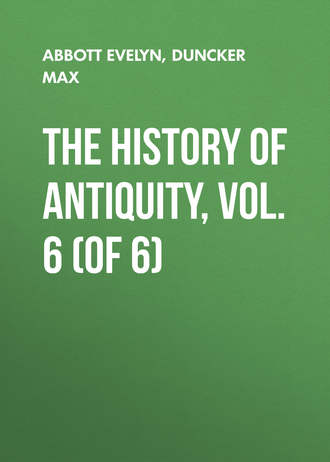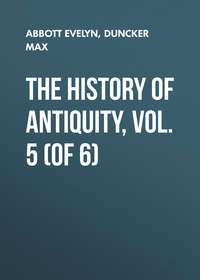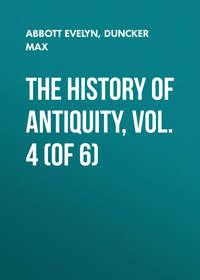 полная версия
полная версияThe History of Antiquity, Vol. 6 (of 6)
After a siege of twenty months Babylon fell in the autumn of the year 519 B.C. Darius tells us further: "Thereupon I went up from Babylon, and marched to Media. The Susiani were overcome with fear, they seized upon Martiya (p. 242), who was their general, and put him to death. When I had reached Media, there is a city, Kudurus (Kunduru) by name, in Media, to which Fravartis marched against me with an army. Then they gave me battle. Auramazda came to my aid. By the grace of Auramazda I severely defeated the army of Fravartis on the 26th day of the month of Adukanis. Then Fravartis with a few horsemen withdrew to the district of Raga in Media. Then I sent an army against them; Fravartis was captured and brought to me. I cut off his nose, ears, and tongue. He was kept in chains at my gate; all the people saw him. Then I crucified him at Hangmatana (Ecbatana), and the men who were his principal adherents I imprisoned in the citadel of Hangmatana. Then I sent a Persian army from Raga to Vistaçpa, and when it had reached him, he marched out with it. There is a city Patigrabana236 in Parthia, there Vistaçpa severely defeated that rebellious army on the 1st day of the month of Garmapada; he slew 6560 of them, and took 4182 captives. Then the land of Parthia was mine. I sent Vaumiça a Persian, my servant, to Armenia; when he came there the rebels collected to give battle to Vaumiça. At Achitu in Assyria my army defeated the rebels on the 15th day of Anamaka, and slew 2024 of them. A second time they gathered together and marched against Vaumiça. There is a district Antiyara (Otiara) by name, in Armenia; there they fought on the last day of the month of Thuravahara (Yiyar 30). By the grace of Auramazda my army defeated the rebels severely; they slew 2045 and took 1559 prisoners. Against Chitratakhma (the leader of the rising of the Sagartians), I sent a part of the Persian and Median army.237 I made Takhmaçpada, a Mede, the general. Takhmaçpada fought with Chitratakhma and my army defeated the rebellious army, seized Chitratakhma, and brought him to me. I cut off his nose and ears, he lay in chains at my gate; all the people saw him. Then I crucified him at Arbira (Arbela in Assyria). Dadarshis, a Persian, my servant, the satrap of Bactria, fought a battle with the Margiani (Frada was the leader of the rising here) on the 23rd day of the month of Atriyadiya. By the grace of Auramazda my army defeated the hostile army very severely. Dadarshis slew 4203 of them, and took 6562 prisoners.238 Then the land was mine. Vahyazdata, who called himself Bardiya, sent an army to Arachosia against the Persian Vivana, my servant, the satrap of Arachosia. 'Go up,' he said to them; 'defeat Vivana and the army, which calls itself the army of king Darius.' There is a fortress, Kapisakani by name; there they fought the battle. By the grace of Auramazda my army defeated the rebellious army on the 13th of Anamaka. For a second time the rebels marched against Vivana. In the district of Gandutava (Ganduvada) on the 7th of the month Viyakhna, my army defeated the rebellious army. Then the general of Vahyazdata withdrew with his faithful warriors to a fortress, Arsada by name, in Arachosia. Vivana followed him with an army. Then he seized him and slew him and the captains who were with him. I sent out a part of the Persian and Median army which was with me; I made Artavardiya, a Persian, my servant, the general of it; Artavardiya marched to Persia; the rest of the army went with me to Media. When Artavardiya was in Persia, there is a city Rakha (Racha); to this Vahyazdata who called himself Bardiya marched to fight against Artavardiya. Auramazda came to my aid; on the 12th of Thuravahara my army defeated the army of Vahyazdata very severely. Then Vahyazdata went to Pisicauvada. From thence he marched against Artavardiya and gave him battle. There is a mountain Paraga (Parga) by name; there they fought on the 6th day of Garmapada. By the grace of Auramazda my army defeated that of Vahyazdata; and they seized Vahyazdata and also his chief adherents. Uvadaidaya is a city in Persia; there I crucified Vahyazdata and the captains who were with him."
The connection between these various battles is no doubt as follows. When Babylon had fallen in the autumn of the year 519 B.C. and the new Nebuchadnezzar had been executed, Darius set out in the spring of the year 518 B.C. Hydarnes maintained himself against Phraortes on the western border of Media, Dadarshis against the rebels in Armenia, and Hystaspes in Parthia. The new pretender to the name of Smerdis ruled in Persia, and his attempt to gain possession of the lands farther to the east and of Arachosia was first checked by the defeat which he suffered from the satrap of Arachosia in a battle fought in December of the year 519 B.C. In all these directions, in Armenia and Parthia, help was needed, and the decision lay in Persia and Media. Darius did not direct his march against Persia, but against Media. There, as he acutely saw, lay the main strength of the rebellion. His approach terrified the Susiani; they slay their chief, their king Martiya, and submit. Arrived at the border of Media and Persia, Darius divides his army. To make use of the mutual jealousy of the Persians and Medes, and to prevent any contact of his Median troops with their rebellious kinsmen, he sends the Persian Artavardiya with the Median troops to Persia against Vahyazdata, and with the Persians he marches against Phraortes to Media. Hydarnes waited for him at Campada; the first object was to unite the troops. The road from Susiana to Ecbatana ran through the district of Cambadene. When united with Hydarnes Darius overcomes Phraortes in the month of Adukanis (perhaps in June) of the year 518 at Kudurus, pursues him to Ragha, and takes him prisoner. Before he executed him in front of the citadel of Deioces, Phraortes, and Cyaxares, he had cut off his nose, ears, and tongue, and in this condition he had publicly exhibited him in chains, in order to convince the Medes that they had nothing to hope from the supposed scion of Cyaxares. The rebellion of the Medes is at an end. Darius can divide his forces. From Ragha he sends aid to his father Hystaspes in Parthia, and with this additional aid Hystaspes is able to defeat the rebellion of the Parthians in Garmapada, i. e. in the summer of 518 B.C. At the same time Dadarshis had received the support in Armenia for which he was waiting, under the protection of the fortress of Uhyama. The Persian Vaumiça, who brought up the reinforcements for Darius, defeats the Armenian rebels in Anamaka, i. e. in December of the year 518 B.C.; a second victory of Vaumiça, in Yiyar (May) of the following year (517 B.C.), puts an end to the rebellion in Armenia. A third army was sent by Darius after the fall of Phraortes against the Sagartians; which overpowered them and took their chief Chitratakhma prisoner. Meanwhile Artavardiya, whom Darius had sent from Susiana, when on his march against Phraortes, to check the rebellion in the native land, had fought with success against Vahyazdata. The latter had weakened his forces by sending a detachment to Arachosia. Vivana, the satrap of Arachosia, had repulsed their attack in December 519 at Kapisakani, and in March (Viyakhna) of the year 518 B.C. he had entirely destroyed them. This failure in the east was followed in the same spring by the attack of Artavardiya from the west. First defeated in Thuravahara (April) at Racha, Vahyazdata succumbed in the summer (in Garmapada) at Mount Paraga, five days after Hystaspes had again become master of the Parthians in the north-east of Iran. The forces of the satrap of Bactria, the second Dadarshis, had sufficed to put an end to the rebellion of the Margians.
That which the deed of Çikathauvatis, the assassination of Gaumata in the spring of the year 521 B.C., was intended to prevent, had nevertheless happened. The whole kingdom was disorganised. In ceaseless conflicts, which extended over four years, from the autumn of 521 B.C. to the spring of 517 B.C., Darius had reconquered it, step by step. He had been compelled to reduce by force of arms even the very foundation of it, the native land of Persia, and to carry on once more the conflict between Persia and Media. It had been necessary to repeat the achievements of Cyrus, if not to their full extent yet in part under far more difficult conditions. The new king had passed with success through the severest crisis, and had reorganised the kingdom. This was the result of his indomitable persistence before Babylon. By this means he had retained the Medes and Persians of his army in their fidelity, and by the final success had filled them with self-confidence. The fear which afterwards preceded his arms, certainly rendered more easy the decisive victory of Kudurus and at Mount Paraga.
Darius had not yet reached the goal; the kingdom was not entirely pacified. The reduction of Babylon and the execution of Nebuchadnezzar III. had not eradicated the strong impulse which the Babylonians felt to regain their independence. They were once more carried away by the charm which the name of Nebuchadnezzar exercised upon them: "When I was in Persia and Media," so Darius relates at the close of the third column of the great inscription of Behistun, "the Babylonians became rebellious for the second time. A man of the name of Arakha, an Armenian, rose up in the city of Dubana (Dubala, Dibleh?) in Babylonia. 'I am Nebuchadnezzar, the son of Nabonetus,' such was his falsehood: he made himself master of the city of Babylon and was king. I sent Intaphernes, my servant, a Mede, with an army against Babylon. Intaphernes took Babylon, and slew much people. On the 22nd of the month Markazana, Arakha with his chief adherents was captured;239 then I ordered them to be crucified in Babylon." No doubt Darius had left sufficient garrisons in the two royal citadels of the city which he had conquered with so much trouble, and, therefore, it is the more remarkable that Arakha, who did not rebel in Babylon itself, was able to make himself master of the city. We may assume that Darius did not give the Babylonians time to fill up the breaches which he had made in the walls of Babylon; this time the Median Intaphernes must have found the task lighter. The second rising of the Babylonians seems to have seduced the Susiani, and to have caused a third rebellion of this land. In a fifth column, subsequently added to the inscription of Behistun, we have information about this rebellion of the Susiani and the reduction of the Sacæ. But this part of the inscription is so greatly injured that only a few words can be read with certainty. All that is clear is that Gaubaruva (Gobryas), the father-in-law of Darius and one of the Seven, was sent against the Susiani and conquered them, that Darius himself marched against the Sacæ, that he fought against the Çaka tigrakhauda, i. e. against the Sacæ with pointed caps, and conquered them on the sea (i. e. on the Caspian), that he captured and slew their chief Çakunka. Polyaenus has preserved a few details of the war against the Sacæ, though they rest on little authority; they prove that it was carried on in the neighbourhood of Bactria, and was a serious struggle.240 Darius recapitulates the narrative of the achievements of the first years of his reign thus: "This is what I accomplished, what I accomplished always with the grace of Auramazda; I have fought nineteen battles, and taken captive nine kings."241
In remembrance of these deeds and achievements, Darius erected a magnificent memorial in that flourishing district of Media which the Medes called Bagistana, i. e. land of the gods. The Choaspes (Kerkha) rises on the southern slope of the Elvend, on the northern slope of which lay Ecbatana. Breaking through the mountain rim of Iran, it flows down a long and narrow valley towards the south into the Lower Tigris. In its upper course the Choaspes traverses an elevated depression, which is now thickly strewn with villages, the chosen summer abode of the shepherd tribes. To the north this depression is bounded by a steep mountain-chain, twenty miles in length, which ends towards the east in a precipitous wall of rock more than 1500 feet high. On this wall, which looks towards the rising sun, over a clear fountain which springs at the foot of the rock, Darius caused a part of the stone 300 feet above the plain to be made smooth with the chisel, polished and cut in relief; the relief is explained by two inscriptions, a shorter one above and a longer one below, in cuneiform letters. At the foot of the rock there was a park (paradisus) twelve stades in the circuit.242 Being placed in Media, this monument was no doubt intended to remind the Medes that any rebellion against the power of the Persians even under the most favourable circumstances would fail. The rock-picture represents Darius, who in size towers over the other figures. He wears a robe which in front falls down over the knee, and behind to the middle of the calf, a crown, a simple fillet with spikes on his head; rings are on his arms, the hair is long, the beard curled. Behind him stand a bow-bearer and a lance-bearer, both with long robes and beards. The king places his right foot on a man lying on the ground. Below this we can read: "This Gaumata, the Magian, lied: he said, 'I am Bardiya, the son of Kurus; I am king.'" Opposite to Darius, bound to each other by a rope round their necks, and their hands tied behind them, stand nine kings with their heads uncovered (the last only has a very tall pointed cap, which marks him as the king of the Çaka tigrakhauda), clothed in various garments. Over the first form, which is clad in a long beautiful robe reaching to the ancles, we read: "This Atrina lied; he said: 'I am king in Susiana'"; and over the second, in a short robe: "This Naditabira lied; he said thus: 'I am Nabukadrachara, the son of Nabunita, I am king of Babylon.'" Near the third figure, also in a short garment, is written: "This Fravartis lied; he said: 'I am Khsathrita, of the race of Uvakhshathra, I am king in Media.'" The fourth wears Persian clothing: "This Martiya lied; he said; 'I am Ymani, king in Susiana.'" Over the fifth form we find: "This Chitratakhma lied; he said: 'I am king in Sagartia, of the race of Uvakshathra.'" Over the sixth, who is clothed as a Persian: "This Vahyazdata lied; he said: 'I am Bardiya, the son of Kurus; I am king.'" Over the seventh prisoner, who is clothed like the second, we read: "This Arakha lied; he said thus: 'I am Nabukadrachara, the son of Nabunita; I am king in Babylon.'" Over the eighth, who wears Persian garments: "This Frada lied; he said thus: 'I am king in Margiana.'" The ninth stands a little further back; the inscription tells us: "This is Çakunka, the Sacian." The picture does not mention the conquest of the Parthians, Hyrcanians, Assyrians, Armenians, and Sattagydae. In the midst, above the whole description, hovers Auramazda, a solemn, aged countenance, with long hair and beard, visible only to the knees, in a winged circle.
Under this picture, at the close of the fourth column, before the account of the new rebellion of the Susiani and the subjugation of the Sacæ, the inscription tells us: "What I have done, I have done by the grace of Auramazda. Auramazda came to my aid, and the other gods, who did so because I was not hostile; because I was not a liar or violent. Thou, who readest these inscriptions, may they tell thee what I have done. Regard them not as lies. These lands which became rebellious to me, the lie made them rebellious. Thou who wilt be king hereafter, guard against the lie. Punish severely the man who is a liar; if thou keepest this mind, my land will be powerful. Thou who seest this tablet hereafter, destroy it not. If thou preservest it as long as thou canst, Auramazda will be favourable to thee; thou wilt have descendants, and live long, and may Auramazda cause that to succeed which thou dost undertake. If thou destroyest this tablet, may Auramazda smite thee, may he give thee no posterity, and what thou doest may he render vain.243"
CHAPTER XV
THE ACHIEVEMENTS OF DARIUS ON THE INDUS AND THE DANUBE
Aeschylus represents the Persians as saying, "A great, prosperous, victorious life was granted to us by destiny, when King Darius, the lord of the bow, Susa's beloved captain, governed the land, without fault or failure, like a god. The Persians called him their divine counsellor: he was filled with a godlike wisdom, and wisely did he, the Susa-born god of Persia, lead our army. We were seen in splendid array; there was ready for him the unwearying might of armed men, and troops mingled from all nations, and the return from the wars was glorious. According to his will, he ruled the wealthy populous cities of the Greeks in the land of Ionia, and the wave-beaten islands of the seas, adjacent to that land, Chios, Lesbos and Samos rich in olives, and Lemnos between both shores, and the cities of Cyprus, Paphos, Soli, and Salamis. Many cities he took adjacent to the Thracian borders on the Strymonian Sea: even the walled cities, far from the shore, obeyed him, and the famous cities on the strait of Helle, on the bay of the Propontis, and the mouth of the Pontus. Beloved hero, thy like lies not in the land of Persia."244
The rebellions were crushed, the kingdom of Cyrus was once more established. Darius took precautions to prevent the recurrence of such serious dangers, and to bring the nations into a lasting state of dependence. He created fixed districts for government, strengthened the action of the central power, secured the necessary means for this, and sought to arrange the taxes and tributes of the provinces and settle them at fixed contributions. Along with this improvement in the organization of the kingdom he kept in sight the extension of it; he did not wish to be left behind Cyrus and Cambyses in this respect. We cannot decide whether the northern boundary of the kingdom reached the Caucasus in the time of Cyrus; it is certain that under Darius the nations between the Black and the Caspian Sea, the Colchians, the Tibarenes, Chalybes, Moschians, and Saspeires, were subject to the Persians. Herodotus observes that the Colchians and their neighbours paid the tribute which they had imposed upon themselves – which implies that these nations submitted voluntarily. "The empire of the Persians," Herodotus tells us, "extends to the Caucasus; the territory to the north pays no heed to them."245 It was a considerable gain when the kingdom extended as far as the Caucasus, or included the whole range; for by this means it acquired a strong natural border, and at the same time controlled the trading road which ran from the east and the Caspian Sea through the valleys of the Cyrus (Kur) and the Phasis to the Black Sea.
In the East Cyrus, as we saw, had already advanced as far as the Indus; he had conquered the Açvakas on the north of the Cabul, and the Gandaras to the south of that river. Of their neighbours, Bactria and Arachosia had remained true during the great rebellion, though the Sattagydæ (the Gedrosians) had revolted. Darius had himself marched against the Sacæ, and reduced them again to subjection. Herodotus tells us, that he sent out a party to explore the Indus; in which was Scylax, an inhabitant of Caryanda in Caria. They set out from the land of the Pactyes (i. e. from Arachosia), and from the city of Caspatyrus (Cabul) they followed the course of the Indus to the sea. Then they sailed to the west, and in the thirtieth month they arrived at the point from which the Phenicians started, who sailed round Africa at the command of Necho (III. 313), i. e. they did not return to the Persian Gulf but sailed round Arabia, and landed in the north-west corner of the Arabian Gulf at Heroonpolis. After their return Darius made use of this sea, and subjugated the Indians.246 The extension of the Persian kingdom in the land of the Indus, by Darius, is beyond a doubt. In the inscription which he caused to be engraved on Mount Behistun after the suppression of the rebellions, he enumerates the nations which obey him. We can find but one name of an Indian nation to the right of the Indus – the Gandaras. The inscription of the palace of Persepolis, which Darius built a few years later, mentions the Idhus, i. e. the Indians, besides the Gandarians. Herodotus further informs us that it was the Northern Indians whom Darius had subjugated. They formed the twentieth satrapy of his kingdom, while the Gandarians were united with the Arachoti in the seventh satrapy. The twentieth satrapy of Northern Indians comprised the lands to the north of Cabul, on the right bank of the stream, from the land of the Açvakas as far as the summits of the Himalayas. It paid 360 talents of gold, the highest tax among all the satrapies of the kingdom.247
In the west Darius pursued even more extensive plans. If Cambyses had trodden the soil of Africa, his armies were to cross the western sea, and carry the empire of Persia into Europe – a point which none of the great warrior princes of the east had as yet reached. Diodorus tells us, that Darius, filled with eager desire to extend his dominion, master of almost all Asia, and trusting to the magnitude of the Persian power, desired to conquer Europe as his ancestors had defeated the mightiest nations with less forces.248 The first achievement of Darius in this direction was the conquest of Samos, the most powerful and prosperous of the islands on the coast of Asia Minor. Oroetes had already prepared the way for this by inviting Polycrates to Magnesia and there putting him to an ignominious death, for when Polycrates was master of Samos and at the head of the splendid naval power which he had created he could contest with Persia the possession of the Ægean (p. 143, 231). Polycrates had left the most trusted of his dependents, Maeandrius, as regent during his absence. On the news of the death of Polycrates, he declared his willingness to lay down his power. But when the nobles of Samos demanded an account of the treasures of Polycrates which were in the hands of Maeandrius, he treacherously seized those who made the demand, threw them into prison, and maintained himself as tyrant. At an earlier time, Polycrates, in close union with his two brothers, Pantagnotus and Syloson, had made himself master of Samos: he then removed the former out of his path, and sent the second into banishment. Syloson went to Egypt to amuse himself with the sights of the country. There, according to Herodotus, he was one day seen by Darius, who was then in Egypt with Cambyses, in the market-place of Memphis, clad in a red cloak. The cloak pleased Darius and he wished to purchase it, but Syloson hastened to offer it as a present to the Persian prince. When Darius became king, Syloson went to Susa, as Herodotus relates, placed himself at the gate of the palace, and told the door-keeper that he had done a service to the king. Darius in astonishment at such an assertion from a Greek, caused Syloson to be brought, remembered the cloak, and was prepared to reward the gift by a liberal present of gold and silver. But Syloson urged the king to restore him to the throne of Polycrates, which was now in the hands of a man who had been a slave in his family; the island was to be spared.249
Whether this narrative has any real foundation or not (in any case Susa must be struck out) Darius found it advantageous to get Samos into his power; and, as we have seen, it was a maxim from the time of Cyrus to set up princes in the maritime cities and the islands, who owed their power to the Persians, and who could only maintain it with their help. He commanded Otanes, whose service in the assassination of the Magi we know, to cross over into Samos. The Samians had no inclination to fight in the cause of Maeandrius, nor did they venture to resist the Persians. When Otanes landed with the Persian troops, Maeandrius with his dependants retired into the citadel, and sent a message to Otanes that he was prepared to quit the island. When this had been agreed upon, the captains of the Persians waited without suspicion before the citadel for the departure of Maeandrius and his associates, and for the opening of the gates. Then the half-witted brother of Maeandrius, Charilaus, who had been confined in prison in the citadel, burst forth from the open gates with the old mercenaries of Polycrates and fell upon the nearest Persians, who in reliance on the treaty were unprepared for an enemy, and cut the captains down, while Maeandrius passed by a subterranean passage to the sea, and embarked on board ship. The mass of the Persians hastened to the rescue; the mercenaries were driven back into the citadel. Enraged at the treachery, Otanes gave the command to cut down all the Samians who fell into the hands of the Persians both within and without the walls. The city was set on fire, and the flames injured the temple of Hera, which was the largest building in Greece after the temple of Artemis at Ephesus. When the citadel had fallen, Syloson received from the Persians (516 B.C.) the ruined city and the desolate island. He enjoyed the throne but a short time, which he had purchased by the ruin of the flourishing country, and vassalage to the great king.250 The island recovered from the blow which it received from the Persians. Twenty years after the subjugation it could once more equip and man 60 triremes.






